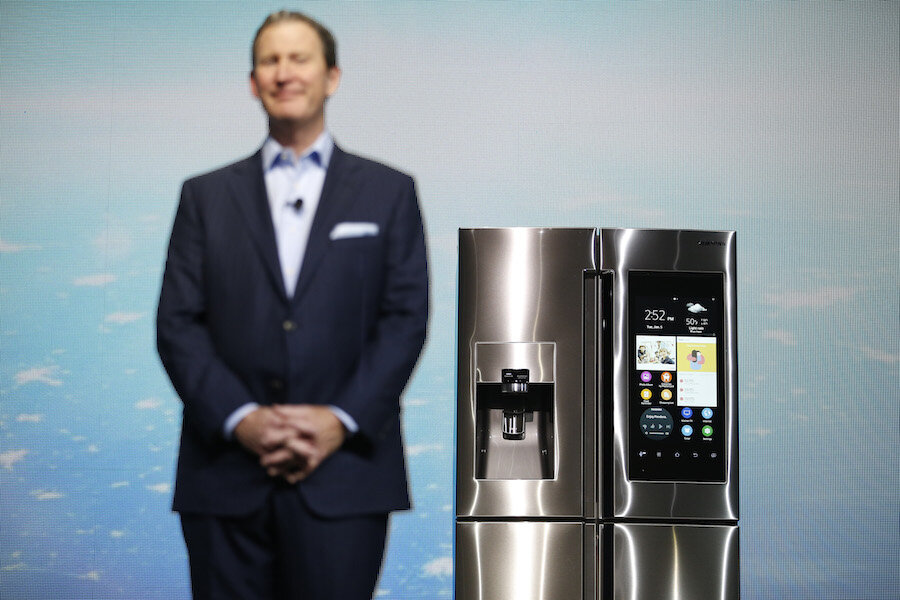CES 2016: How smart can your home get?
Loading...
On Sunday, Mark Zuckerberg set his goal for 2016 via a Facebook post: build an artificial intelligence to run his home and assist his work, “like Jarvis in Iron Man.”
The lofty ambition fits a growing trend of “smart” home technology, which links smartphones, tablets, and other computers with household appliances and other home items.
High-powered commercial drones, self-driving cars, and virtual reality dominated the presentations at the annual Consumer Electronics Show (CES) in Las Vegas, with Microsoft announcing its intention to become the “ultimate platform for all intelligent cars” and Intel showing how its new drone can dodge falling trees. But Samsung aimed closer to home.
During its CES press conference, the South Korean company focused on new its new “SmartThings” appliances, which range from televisions to washing machines.
“We wanted to offer consumers a new type of experience,” said Chris Turkstra, vice president of Samsung's Customer Experience Lab, in reference to new smart televisions.
Samsung revealed a new version of a product that became “smart” years ago: televisions. The company’s new ultra-high-definition televisions, which range from 49 inches to 88 inches, feature 10-bit display technology and “the world’s first bezel-less curved design,” according to Samsung.
Along with the upgraded hardware, the new televisions feature an upgraded version of “Smart Hub,” the interface where users can surf the Web or access streaming services without switching sources, and the televisions themselves can act as remote controls for up to 200 Samsung SmartThings devices. The large amount of possible connections could foreshadow big plans for expanding the SmartThings line.
Samsung also brought their SmartThings technology to the kitchen, with its first “smart” fridge. The Family Hub Refrigerator is connected to the SmartThings hub, and features an attached 21.5-inch screen, where users can check inventory, shop online, or monitor their eating habits without opening the door – the fridge takes a picture of its inventory when the door is closed, courtesy of sensors and three cameras inside. The contents of the fridge can be monitored remotely.
The downside? Samsung's refrigerator costs $5,000, enough for 10 non-smart fridges or an even greater number of tablets. What's more, as TechCrunch's Romain Dillet points out, the fridge's technology is likely to get old fast:
Putting a tablet in a fridge poses multiple issues. First, you can’t update the hardware. Wi-Fi standards evolve, and chances are 802.11n or 802.11ac won’t be around anymore in 15 years. Similarly, your brand new shiny tablet from 2020 will be much better than the one stuck on your fridge — faster, compatible with your Wi-Fi, etc.
Samsung also seeks to make laundry easier, with its new “smart” washer, the WW8500 AddWash. The washer was toted in the Samsung press release as a solution to the challenge of adding laundry to a front-load washer after it fills with water. With the WW8500 AddWash, extra laundry and detergent can be added at anytime during the washing process.
The AddWash washer also features technology that allows users to monitor the progress of their laundry from their phones and alerts users at the end of a cycle, according to the press release.
These new appliances are in addition to the “SmartThings” lineup of appliances Samsung has already established. The SmartThings Starter Kit for example comes with all users need to monitor lights, temperature, and security in their homes.
Samsung’s latest products indicate the direction smart home technology is heading, but their products scratch the surface of a rapidly emerging market with already entrenched products. Nest, a popular Web-enabled thermostat, has become the standard comparison for new thermostats entering the market, and Amazon Echo, a voice-controlled media and home-automation hub, has already garnered a devout following.
A February MarketsandMarkets report forecasts the “Smart Homes Market” reaching $58.68 billion by 2020.






